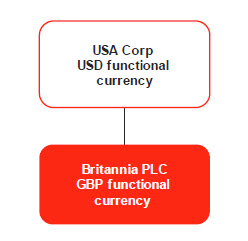Search within this section
Select a section below and enter your search term, or to search all click Foreign currency
Favorited Content
Once the functional currency for a foreign entity is determined, that determination shall be used consistently unless significant changes in economic facts and circumstances indicate clearly that the functional currency has changed. Previously issued financial statements shall not be restated for any change in the functional currency.
Change |
Accounting summary |
From the currency of the reporting entity to a local currency
|
Nonmonetary assets and liabilities, as stated in the local currency (i.e., the new functional currency), are translated using the exchange rate in effect at the date of the change. The difference between the consolidated historical carrying values (which would have been a function of the exchange rate that existed when the assets or liabilities arose), and the new translated values using the current exchange rate, is recorded to the cumulative translation adjustment (CTA) account.
Monetary assets and liabilities not denominated in the reporting currency are translated at the current exchange rate at the date of the change. This process will produce the same carrying values produced from the measurement process that was performed prior to changing the functional currency. To the extent that the distinct and separable operation has monetary assets and liabilities denominated in the reporting currency, such balances will create transaction gains and losses subsequent to the change in functional currency.
|
From a local currency to the currency of the reporting entity (including changes due to a highly inflationary economy)
|
The translated balances of monetary and nonmonetary assets and liabilities recorded in the reporting entity’s consolidated financial statements as of the end of the prior reporting period become the new accounting basis for those assets and liabilities in the period of the change. To the extent that the distinct and separable operation has monetary assets and liabilities denominated in the old functional currency, such balances will create transaction gains and losses subsequent to the change in functional currency.
The balance recorded in the CTA account for prior periods is not reversed upon the change in functional currency.
|
From a local currency to a new local currency
|
Nonmonetary assets and liabilities should be remeasured into the new functional currency, using the exchange rate on the date the asset or liability arose. These amounts should then be translated into the reporting entity’s reporting currency based on current exchange rates. The difference between this amount and the prior translated balance should be recorded in CTA.
Monetary assets and liabilities not denominated in the new local currency should be remeasured into the new functional currency, based on the exchange rate at the date of the change in functional currency. These amounts should then be translated into the reporting entity’s reporting currency based on current exchange rates. To the extent that the distinct and separable operation has monetary assets and liabilities not denominated in the new local currency, such balances will create transaction gains and losses subsequent to the change in functional currency.
The balance recorded in the CTA account for prior periods is not reversed upon the change in functional currency.
|

GBP purchase price |
Exchange rate |
USD balance |
GBP 500,000
|
GBP 1 = USD 1.3
|
USD 650,000
|
USD balance |
Exchange rate |
GBP balance |
USD 260,000
|
GBP 1 = USD 1.3
|
GBP 200,000
|
GBP balance |
Exchange rate |
USD balance |
GBP 200,000
|
GBP 1 = USD 1.3
|
USD 260,000
|
GBP 200,000
|
GBP 1 = USD 1.5
|
USD 300,000
|
PwC. All rights reserved. PwC refers to the US member firm or one of its subsidiaries or affiliates, and may sometimes refer to the PwC network. Each member firm is a separate legal entity. Please see www.pwc.com/structure for further details. This content is for general information purposes only, and should not be used as a substitute for consultation with professional advisors.

Select a section below and enter your search term, or to search all click Foreign currency











